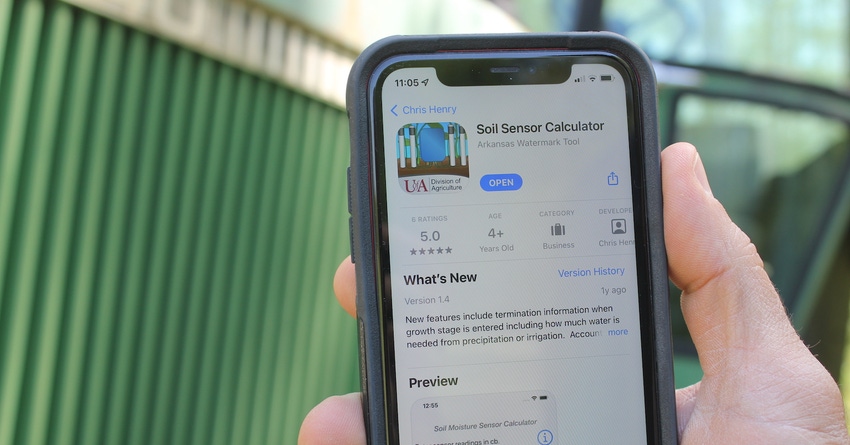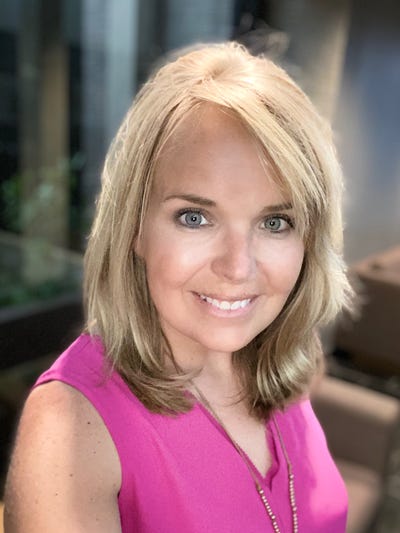
Chris Henry said his phone doesn’t ring quite as much as it used to, and he’s ok with that.
More specifically, Henry, an associate professor and water management engineer with the University of Arkansas, said he receives fewer calls from producers on irrigation questions these days. He attributes that to the university’s mobile software applications that put his irrigation research directly in the hands of growers.
“’When do I need to irrigate?’ is the most common question I receive,” Henry said. “But once growers become comfortable using the apps, they don’t call back.”
“The apps are really easy to use. They take what is really complicated, such as interpreting soil moisture sensor data, and simplify it in a way that allows growers to make irrigation decisions in less than a minute,” he continued.
Henry and the U of A Water Management Team have developed two irrigation management apps — the Arkansas Watermark Tool Soil Sensor Calculator and an app called Rice Irrigation.
The Arkansas Watermark Tool Soil Sensor Calculator allows for the user to enter readings from Watermark brand soil moisture sensors. The app then calculates available water remaining and days to required irrigation.
Rice Irrigation helps farmers quickly and easily develop a rice irrigation plan using multiple inlet irrigation. After users outline an aerial field map and levee placement, the app provides the needed pipe size, length, and thickness, the number of holes for each levee, the blue gate settings, and the number of roles for each field.

The ultimate goal for both apps is to optimize water use in crop production. New research is continuing to make the app recommendations more precise, according to Henry, resulting in improved yields or increased water savings.
Improving Soil Sensor Calculator
The Soil Sensor Calculator was launched four years ago as the state saw a large uptick in soil moisture sensors going in the ground. From 2008 to 2018, the percentage of growers using soil moisture sensors nearly doubled. And Henry said those numbers are continuing to climb. Nearly 90% of the state’s 2021 Most Crop Per Drop irrigation contest used soil moisture sensors.
“Interpreting soil moisture sensor data is really complicated, it’s hard to just look at the numbers and make a decision off of them,” Henry said.
However, when Henry first began demonstrations of sensor-based irrigation decision tools in soybeans, he noticed yields were coming up short by nearly 5 bu/a.
“Most of the early soil moisture sensor data came from Nebraska and Missouri. They have different soil types than we have in the South, and they grow different varieties of soybeans. We knew we had to calibrate the soil moisture sensors to our soils and maturity groups,” Henry said.
To do that, Henry and fellow U of A researchers, Leo Espinoza and Mukhammadzakhrab Ismanov, began a sap flow study at the Lon Mann Cotton Research Station in Marianna, Ark. The painstaking process involved Ismanov crouching and on his belly at times in the soybean canopy during the heat of the day, attaching sensors to each stem on a plant. The sap flow sensors measured plant transpiration rates. Ismanov also removed and measured the area of every leaf of every plant measured over a 10-day period, and from that information, his team could determine how much water soybean plants were using on a per acre basis at every growth stage.
“What we learned is that we need more water to finish a soybean crop in Arkansas than what the older publications indicated,” Henry said. “We now know we need almost another inch of water at the R6 growth stage to finish out the crop.”
“With this new information we can project out really well when it is time to stop irrigation soybeans,” Henry said.
Using irrigation data
Data from the sap flow research, which determines how much water is needed at each growth stage, combined with data from the university’s water retention research, which determines how much water is available in the soils, has all been added to the mobile app, improving the accuracy and experience for producers.
“With the app, users have all of our research in their hands. They can put in their sensor readings, enter their soil type, they pick their allowable depletion, their effective reading depth, they actually pick the growth stage of the crop and how long it’s going to take to irrigate that field, and the app tells them how many days until irrigation should begin.
“They’ll know how long soil moisture will last, and when the app accounts for how long it takes them to irrigate, they receive an action plan.”
“At the end of the season, if they have enough water in the soil to finish the crop out, it tells them they are done,” Henry said.
By fine-tuning the app for Midsouth growing conditions, Henry said farmers can be confident they can capture those last five bushels — a significant gain at current soybean prices. He’s also working on adding yield projections to a future version of the app. If a grower want to hit 100 bu/a soybeans, he or she will be able to enter the yield goal and the app will automatically adjust needed water values.
“Irrigation decisions are never easy, but tools like the soil sensor calculator are helping farmers make better-informed irrigation plans and use their resources more efficiently,” Henry said, adding that “it may even save them a phone call.”
About the Author(s)
You May Also Like






